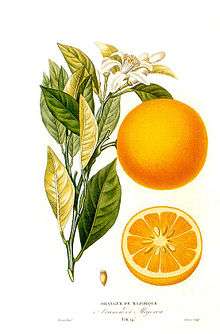Orange oil

Orange oil is an essential oil produced by cells within the rind of an orange fruit (Citrus sinensis fruit). In contrast to most essential oils, it is extracted as a by-product of orange juice production by centrifugation, producing a cold-pressed oil.[1] It is composed of mostly (greater than 90%) d-limonene,[2] and is often used in place of pure d-limonene. D-limonene can be extracted from the oil by distillation.
Composition
The compounds inside an orange oil varies with each different oil extraction. Composition variety happens as a result of regional and seasonal changes as well as the method used for extraction. Several hundred compounds have been identified with gas chromatograph-mass spectrometry. Most of the substances in the oil belong to the terpene group with limonene being the dominant one. Long chain aliphatic hydrocarbon alcohols and aldehydes like 1-octanol and octanal are second important group of substances.
| Compound | Italian Orange Oil[3] Concentration [%] | Valencia orange oil[4] Concentration [%] | Valencia orange oil[5] Concentration [%] | Valencia orange oil[6] Concentration [%] |
|---|---|---|---|---|
| Limonene | 93.67 | 91.4 | 95.17 | 97.0 |
| α-Pinene | 0.65 | 1.4 | 0.42 | – |
| Sabinene and β-Pinene | 1.00 | 0.4 | 0.24 | – |
| Myrcene | 2.09 | 4.3 | 1.86 | 0.03 |
| Octanal | 0.41 | – | - | – |
| Linalool | 0.31 | 0.8 | 0.25 | 0.3 |
| δ-3-Carene | 0.31 | – | – | – |
| Decanal | 0.27 | 0.4 | 0.28 | – |
The presence of sinensetin explains the orange color.[7]
Use
Orange oil is used as a cleaner.
Biological pest control
Orange oil can be used in green pesticides for biological pest control. It can kill ants, and by erasing their scent-pheromone trail indicators disrupts re-infestation.[8]
Orange oil is also known to be useful to control, but not exterminate Drywood termites (Incisitermes.), killing only those who come into direct contact with it.
Hazards
The limonene which is the main component of the oil is a mild irritant, as it dissolves protective skin oils. Limonene and its oxidation products are skin irritants, and limonene-1,2-oxide (formed by aerial oxidation) is a known skin sensitizer. Most reported cases of irritation have involved long-term industrial exposure to the pure compound, e.g. during degreasing or the preparation of paints. However a study of patients presenting dermatitis showed that 3% were sensitized to limonene.
Limonene has been observed to cause cancer in male rats, by reacting with α2u-globulin, which is not produced by female rats. There is no evidence for carcinogenicity or genotoxicity in humans. The IARC classifies d-limonene under Class 3: not classifiable as to its carcinogenicity to humans.[9]
See also
References
- ↑ Dominic W. S. Wong (1989). Mechanism and theory in food chemistry. Springer. p. 253. ISBN 0-442-20753-0.
- ↑ K. Bauer, D. Garbe, and H. Surburg, "Common Fragrance and Flavor Materials", 4th Ed, Wiley VCH, 2001, ISBN 3-527-30364-2. 189.
- ↑ A. Verzera; A. Trozzi; G. Dugo; G. Di Bella; A. Cotroneo (2004). "Biological lemon and sweet orange essential oil composition". Flavour and Fragrance Journal. 19 (6): 544–548. doi:10.1002/ffj.1348.
- ↑ J. Pino *, M. Sánchez, R. Sánchez, E. Roncal (2006). "Chemical composition of orange oil concentrates". Nahrung / Food. 36 (6): 539–542. doi:10.1002/food.19920360604.
- ↑ J. D. Vora; R. F. Matthews; P. G. Crandall; R. Cook (1983). "Preparation and Chemical Composition of Orange Oil Concentrates". Journal of Food Science. 48 (4): 1197–1199. doi:10.1111/j.1365-2621.1983.tb09190.x.
- ↑ R. L. Colman; E. D. Lund; M. G. Moshonas (1969). "Composition of Orange Essence Oil". Journal of Food Science. 34 (6): 610–611. doi:10.1111/j.1365-2621.1969.tb12102.x.
- ↑ Steinke, K., Jose, E., Sicker, D., Siehl, H.-U., Zeller, K.-P. and Berger, S. (2013), Sinensetin. Chemie in unserer Zeit, 47: 158–163. doi:10.1002/ciuz.201300627
- ↑ "A Review of "Organic" and Other Alternative Methods for Fire Ant Control" (PDF). Archived from the original (PDF) on 2 April 2015.
- ↑ "Limonene | My Tamanu Oil - Tamanu Oil Benefits And Uses". MyTamanuOil.com. Archived from the original on 8 January 2016.
- ↑ "Safety data (MSDS) for limonene". Fisher Scientific UK. Retrieved 2015-04-22.